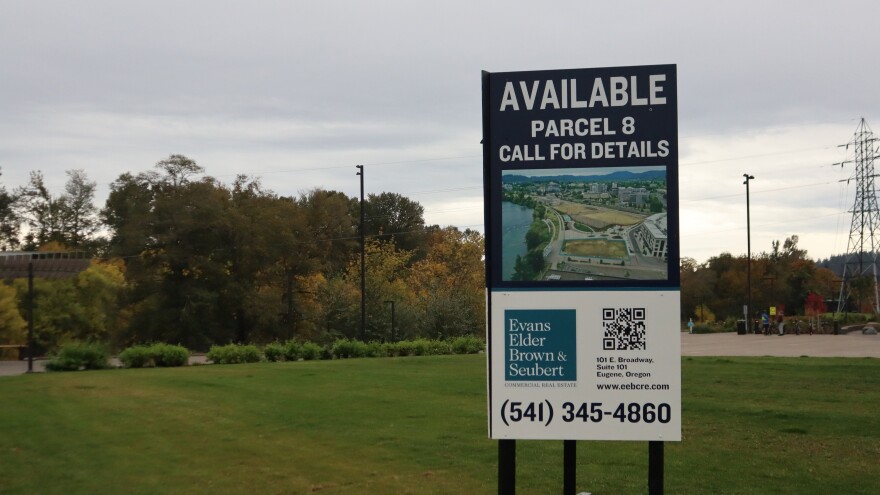This story is part of KLCC's "Down by the River" series. To read the entire series, click here.
As he walked along a Riverfront District path, Eugene’s walking historian Randy Gudeika gestured toward a pair of new apartment buildings and recounted a 2006 article in the Eugene Weekly.
“City Councilor Betty Taylor, she was 80 when she said this, ‘When people talk about going back to the river, it should be for everybody to see, not for just people that have the money,’” Gudeika said. “These aren't exactly affordable housing units.”
Eugene’s median individual income is $40,668 a year, according to U.S. Census data. The Census uses the term rent-burdened to describe a person or household that spends more than 30% of their income on housing.
For a median earner in Eugene, the rent-burdened line is $1,017 a month.
As of this fall, the cheapest available units in the two newly opened apartment buildings in the Riverfront District are almost $500 above that. And most units in the Portal and the Heartwood are more than double what would be affordable for a median salary.
This housing is considered market-rate, and the housing market is expensive right now. Those costs can be higher when a builder is recouping the cost of new construction.
“To make it a value proposition for our customers, we have to make it very nice, just because the building itself, we know will be expensive, just because of where construction costs and inflation have taken us,” said Riverfront District Developer Jim Atkins.

But, the Riverfront will not be entirely market-rate housing. Of the 500-700 units planned in the area, somewhere between 10-15% will be designed with lower to median income renters in mind.
“We've partnered with Lane County's Homes for Good, Lane County's affordable housing provider, to develop and deliver a 75 unit project, similar in all aspects on the exterior to the work that we did at Portal across the street,” said Atkins. “We've submitted that application now to the state, and we hope to begin construction of that next year.”
And those affordable homes are going through the planning process, from zoning to the city’s Multi-Unit Property Tax Exemption, which waives property taxes on qualifying new construction for up to 10 years.
“We've successfully been through the MUPT application process and design review, and we've received approval on those,” said Atkins. “Really, it's a matter of just the financing markets, getting Portal fully leased up, and being able to then pivot to one of the next projects.”
Beyond more homes, the area will not rely on the neighboring Fifth Street District for all of its stores and restaurants.
“We have three retail properties that we're actively marketing and looking for a retail partner to come and develop and operate with us,” he said.
But, on the south end of the Riverfront development is a spot that is untouched thus far, a dilapidated steam plant that was built in 1931.

For many, including Eugene’s walking historian, the status of the former EWEB power plant remains a mystery.
“I'm not going to talk about that now, other than to say there were plans to redo it, but that was a while ago,” said Gudeika. “And Miksis Development, they haven't done anything yet. Don't know when they will. Don't know what their financing is going to be like.”
That sentiment was echoed by a top city staffer, who offered a limited update.
“It's a tremendous opportunity, because you will never build that close to the river, probably ever again,” said Eugene Planning and Development Executive Director Denny Braud.
A 2021 presentation showed plans to build office space, a restaurant and an “indie hotel” inside the nearly 100-year-old walls.
In 2022, developers Mark Miksis and Mark Frohnmayer bought the building from the city for $1.
Miksis did not agree to an interview for this story, but did say there could be upcoming developments in the months ahead.
To the north of the steam plant, Randy Gudeika hypothesized about what else could happen in the area. He has heard talk among citizens about taking down the Ferry Street Bridge to re-establish Eugene’s mill race as a scenic waterway.

“Up until this new [Riverfront] District was built, I would have said they were full of horse apples. But these people, over time, I think they'll be a powerful motivator. Not during my lifetime, but in years from now, maybe they will take this down like they took down the Embarcadero Freeway in San Francisco, and maybe they will restore the mill race, something that maybe your children will see, or maybe your grandchildren.”
Afterall, the project of turning the Riverfront District from industrial land to multi-family housing hub is already decades in. Who knows what new projects will be underway decades into its future?







